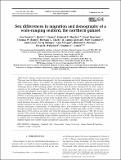Files in this item
Sex differences in migration and demography of a wide-ranging seabird, the northern gannet
Item metadata
| dc.contributor.author | Deakin, Zoe | |
| dc.contributor.author | Hamer, Keith C. | |
| dc.contributor.author | Sherley, Richard B. | |
| dc.contributor.author | Bearhop, Stuart | |
| dc.contributor.author | Bodey, Thomas W. | |
| dc.contributor.author | Clark, Bethany L. | |
| dc.contributor.author | Grecian, W. James | |
| dc.contributor.author | Gummery, Matt | |
| dc.contributor.author | Lane, Jude | |
| dc.contributor.author | Morgan, Greg | |
| dc.contributor.author | Morgan, Lisa | |
| dc.contributor.author | Phillips, Richard A. | |
| dc.contributor.author | Wakefield, Ewan D. | |
| dc.contributor.author | Votier, Stephen C. | |
| dc.date.accessioned | 2019-09-05T12:30:02Z | |
| dc.date.available | 2019-09-05T12:30:02Z | |
| dc.date.issued | 2019-07-18 | |
| dc.identifier | 261030792 | |
| dc.identifier | 6f7b9b73-69f1-4c13-b2e0-68786e32f64b | |
| dc.identifier | 85068565861 | |
| dc.identifier | 000485735400013 | |
| dc.identifier.citation | Deakin , Z , Hamer , K C , Sherley , R B , Bearhop , S , Bodey , T W , Clark , B L , Grecian , W J , Gummery , M , Lane , J , Morgan , G , Morgan , L , Phillips , R A , Wakefield , E D & Votier , S C 2019 , ' Sex differences in migration and demography of a wide-ranging seabird, the northern gannet ' , Marine Ecology Progress Series , vol. 622 , pp. 191-201 . https://doi.org/10.3354/meps12986 | en |
| dc.identifier.issn | 0171-8630 | |
| dc.identifier.other | ORCID: /0000-0002-6428-719X/work/61370167 | |
| dc.identifier.uri | https://hdl.handle.net/10023/18428 | |
| dc.description | The work was funded by the Natural Environment Research Council (Standard Research Grant NE/H007466/1) and donations from Evan Fountain (In Memoriam donations for Issy Fountain) and Mike Matthewson. | en |
| dc.description.abstract | Marine vertebrates show a diversity of migration strategies, including sex differences. This may lead to differential demography, but the consequences of such between-sex variation are little understood. Here, we studied the migration of known-sex northern gannets Morus bassanus — a partial migrant with females ~8 % heavier than males. We used geolocators to determine wintering areas of 49 breeding adults (19 females and 30 males during 2010 to 2014) from 2 colonies in the northeast Atlantic (Bass Rock and Grassholm, UK). We also tested for sex-specific survival probabilities using capture−mark−recapture methods (n = 72 individuals Bass Rock, n = 229 individuals Grassholm; 2010−2018) and applied sex-specific population projection matrices (PPMs) to quantify population-level effects. Tracked gannets wintered in a range of large marine ecosystems (LMEs): Canary Current LME (CCLME; 69 %), Celtic-Biscay Shelf LME (16 %), Iberian Coastal LME (8 %), North Sea LME (4 %) or Mediterranean LME (2 %). Migratory destination differed between the sexes: 90 % of females vs. 57 % of males wintered in the CCLME. Survival was similar between the sexes at Bass Rock (mean ± 95 % CI = 0.951 ± 0.053 and 0.956 ± 0.047 for females and males, respectively). At Grassholm, there was evidence of slight sex differences in breeder survival: females had lower annual survival (0.882 ± 0.040) than males (0.946 ± 0.026). At Bass Rock, PPMs with no sex effect best fitted the observed population increase (1994−2014). Sex-specific PPMs fitted the population estimates for Grassholm (1995−2015). Our results reveal that female gannets are more likely to travel further than males to winter in the CCLME. This difference is unlikely due to morphological differences, unlike in other bird species. However, the reason for slightly higher over-winter female mortality at Grassholm is unclear. | |
| dc.format.extent | 11 | |
| dc.format.extent | 528384 | |
| dc.language.iso | eng | |
| dc.relation.ispartof | Marine Ecology Progress Series | en |
| dc.subject | Canary current | en |
| dc.subject | Capture–mark–recapture | en |
| dc.subject | Geolocator | en |
| dc.subject | Large marine ecosystem | en |
| dc.subject | Migratory | en |
| dc.subject | Seabird | en |
| dc.subject | Sex | en |
| dc.subject | QH301 Biology | en |
| dc.subject | Ecology, Evolution, Behavior and Systematics | en |
| dc.subject | Aquatic Science | en |
| dc.subject | Ecology | en |
| dc.subject | NDAS | en |
| dc.subject | SDG 14 - Life Below Water | en |
| dc.subject.lcc | QH301 | en |
| dc.title | Sex differences in migration and demography of a wide-ranging seabird, the northern gannet | en |
| dc.type | Journal article | en |
| dc.contributor.institution | University of St Andrews. Scottish Oceans Institute | en |
| dc.contributor.institution | University of St Andrews. Sea Mammal Research Unit | en |
| dc.contributor.institution | University of St Andrews. School of Biology | en |
| dc.identifier.doi | 10.3354/meps12986 | |
| dc.description.status | Peer reviewed | en |
This item appears in the following Collection(s)
Items in the St Andrews Research Repository are protected by copyright, with all rights reserved, unless otherwise indicated.

